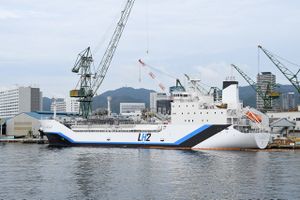Suiso Frontier

The Suiso Frontier is the world's first cyrogenic tanker designed to carry liquid hydrogen.[1] The vessel was built by Kawasaki Heavy Industries as a technology demonstrator, to try to show that shipping industrial quantities of liquid hydrogen could play a significant role in the world's energy economy.[2]
The vessel is capable of carrying 1,250 cubic metres of liquid hydrogen in a single sperical insulated double walled tank.[1][3] She was completed in 2021. Her cruising speed is 13 knots, and she has capacity for a complement of 25.
Kawasaki finished special port facilities, in the port city of Kobe, Japan, to handle and store large volumes of liquid hydrogren, on January 22, 2021.[4] The storage tank built in the port has twice the capacity of the Suiso Frontier.
The vessel underwent over a year of tests before ClassNK was ready to certify it was ready to join Japan's merchant fleet.[5]
On December 24, 2021, the vessel left Kobe, Japan to pick up its first shipment of liquid hydrogen produced from brown coal gasification, from Australia.[6][7]
Kawasaki Heavy Industries (KHI) built the vessel as part of its membership in HySTRA (Hydrogen Energy Supply-Chain Technology Research Association).[8] The vessel will be operated by Shell/STASCO. The Kobe port facility (Hy touch Kobe), will be operated by Iwatani Corporation.
References
- ↑ 1.0 1.1 Jasmine Ovcina. Suiso Frontier conducts berthing trial at Kobe LH2 Terminal, Offshore energy, 2021-03-21. Retrieved on 2021-12-27. “The vessel disposes 8,000 tons in gross tonnage and is designed to transport large quantities of liquefied hydrogen at 1/800 of its original gas-state volume, cooled to –253°C, over long distances by sea.”
- ↑ World's First Liquefied Hydrogen Carrier SUISO FRONTIER Launches Building an International Hydrogen Energy Supply Chain Aimed at Carbon-free Society, Kawasaki Heavy Industries, 2019-12-11. Retrieved on 2021-12-27. “Once complete, the SUISO FRONTIER will be used for technology demonstration testing in Japanese FY 2020 aimed at the establishment of an international hydrogen energy supply chain*1 in which liquefied hydrogen produced in Australia will be shipped to Japan.”
- ↑ Takeo Kumagai. Japan-flagged Suiso Frontier set for world's first marine transport of liquefied hydrogen, S&P Global, 2021-12-15. Retrieved on 2021-12-27. “The 8,000 gross tonnes Suiso Frontier, the world's first liquefied hydrogen carrier with a cargo loading capacity of 1,250 cu m, is using one of the two storage tanks for carrying some 75 mt of liquefied hydrogen for this transport, the source said.”
- ↑ Jasmine Ovcina. Kawasaki Heavy Industries builds the world’s 1st liquefied hydrogen receiving terminal, Offshore energy, 2021-01-22. Retrieved on 2021-12-27.
- ↑ Sam Chambers. World’s first liquefied hydrogen carrier readies for deployment, Splash 247, 2021-12-06. Retrieved on 2021-12-27. “The ship has been undergoing extensive tests for the past year. Japanese classification society ClassNK has just given the ship the green light, adding it to its register.”
- ↑ Kawasaki Heavy says liquefied hydrogen carrier departs Japan for Australia, Reuters, 2021-12-24. Retrieved on 2021-12-27. “A one-way trip takes about 16 days.”
- ↑ Sanja Pekic. World’s 1st LH2 carrier Suiso Frontier departs for Australia, Offshore energy, 2021-12-24. Retrieved on 2021-12-27. “KHI built the world’s first liquefied hydrogen carrier Suiso Frontier last year. The shipbuilder has completed this under the CO2-free Hydrogen Energy Supply-chain Technology Research Association (HySTRA) membership.”
- ↑ World’s first liquefied hydrogen carrier SUISO FRONTIER officially classified by ClassNK, Hydrogen Energy Supply-Chain Technology Research Association, 2021-12-03. Retrieved on 2021-12-27. “SUISO FRONTIER was built by Kawasaki Heavy Industries, Ltd. and will be managed and operated by Shell/STASCO while transporting hydrogen produced in Australia by Electric Power Development Co., Ltd. (J-POWER) to Liquefied Hydrogen Receiving terminal "Hy touch Kobe”, which is managed and operated by Iwatani Corporation.”